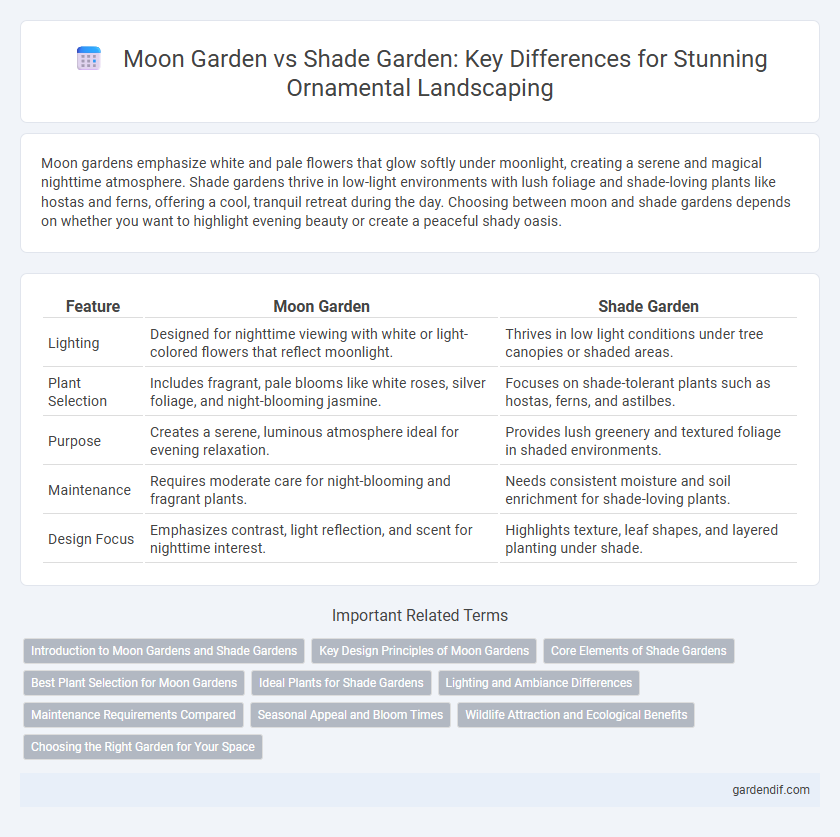
Moon Garden vs Shade Garden Illustration
Moon gardens emphasize white and pale flowers that glow softly under moonlight, creating a serene and magical nighttime atmosphere. Shade gardens thrive in low-light environments with lush foliage and shade-loving plants like hostas and ferns, offering a cool, tranquil retreat during the day. Choosing between moon and shade gardens depends on whether you want to highlight evening beauty or create a peaceful shady oasis.
Table of Comparison
| Feature | Moon Garden | Shade Garden |
|---|---|---|
| Lighting | Designed for nighttime viewing with white or light-colored flowers that reflect moonlight. | Thrives in low light conditions under tree canopies or shaded areas. |
| Plant Selection | Includes fragrant, pale blooms like white roses, silver foliage, and night-blooming jasmine. | Focuses on shade-tolerant plants such as hostas, ferns, and astilbes. |
| Purpose | Creates a serene, luminous atmosphere ideal for evening relaxation. | Provides lush greenery and textured foliage in shaded environments. |
| Maintenance | Requires moderate care for night-blooming and fragrant plants. | Needs consistent moisture and soil enrichment for shade-loving plants. |
| Design Focus | Emphasizes contrast, light reflection, and scent for nighttime interest. | Highlights texture, leaf shapes, and layered planting under shade. |
Introduction to Moon Gardens and Shade Gardens
Moon gardens feature plants with white or silver foliage and blooms that reflect moonlight, creating a luminous nighttime landscape. Shade gardens are designed for areas with limited sunlight, utilizing plants adapted to thrive in lower light conditions. Both garden styles emphasize specific plant selections to enhance aesthetic appeal under varying light environments.
Key Design Principles of Moon Gardens
Moon gardens prioritize the use of white or pale-colored plants and reflective surfaces to maximize visibility and create a luminous ambiance during nighttime. Incorporating fragrant blooms such as jasmine and gardenias enhances sensory appeal, while placing seating areas strategically allows for restful enjoyment of soft, moonlit landscapes. Selecting plants with varying textures and subtle movements ensures visual interest without overwhelming the serene, contemplative atmosphere typical of moon gardens.
Core Elements of Shade Gardens
Shade gardens rely on core elements such as low-light tolerant plants, rich soil with high organic content, and moisture retention to create a lush, inviting space. Moon gardens emphasize reflective surfaces and light-colored foliage to maximize visibility in low light, while shade gardens prioritize textures and layered planting to enhance depth and interest under tree canopies. Key plant selections for shade gardens include ferns, hostas, and astilbes, which thrive in subdued sunlight and contribute to the garden's tranquil atmosphere.
Best Plant Selection for Moon Gardens
Moon gardens thrive with plants that reflect moonlight, such as white or silver foliage and blooms like white hydrangeas, gardenias, and lamb's ear. Shade gardens demand plants that tolerate lower light levels, including hostas, ferns, and astilbes, but these may lack the luminous quality ideal for moon gardens. Optimal moon garden plant selection emphasizes flowers and foliage that brighten nighttime spaces, enhancing evening ambiance with reflective colors.
Ideal Plants for Shade Gardens
Ideal plants for shade gardens include hostas, ferns, and astilbes, which thrive in low-light conditions and provide lush foliage and texture. These plants contrast with moon garden selections, which often favor reflective, light-colored blooms like white phlox or evening primrose to enhance nighttime visibility. Shade gardens benefit from incorporating plants with varying leaf shapes and shades of green to create depth and interest without relying on bright sunlight.
Lighting and Ambiance Differences
Moon gardens emphasize luminescent plants and reflective surfaces that enhance visibility under moonlight, creating a serene and mystical ambiance. In contrast, shade gardens rely on dappled natural light with dense foliage that fosters a cool, tranquil environment perfect for relaxation during daylight hours. The lighting in moon gardens highlights night-blooming flowers like white gardenias and silver-leaved plants, whereas shade gardens showcase texture and depth through ferns, hostas, and shade-tolerant blooms.
Maintenance Requirements Compared
Moon gardens, designed with white and silver foliage plants, typically require less maintenance due to their drought-tolerant species and minimal pruning needs. Shade gardens, featuring plants like hostas and ferns, demand more frequent watering and regular debris removal to prevent mildew and support healthy growth. Both garden types benefit from seasonal mulching, but shade gardens often require more intensive care to manage moisture levels and plant health.
Seasonal Appeal and Bloom Times
Moon Gardens feature night-blooming flowers such as moonflowers and white evening primrose that illuminate the garden during summer and early fall, creating a luminous nighttime display. Shade Gardens thrive with plants like hostas and astilbes that offer continuous greenery and sporadic blooms from spring through early autumn, providing year-round textural interest in low-light areas. Seasonal appeal in Moon Gardens peaks during warm months with vivid nocturnal blooms, while Shade Gardens maintain steady visual charm through varied foliage and staggered flowering periods.
Wildlife Attraction and Ecological Benefits
Moon gardens, designed with light-reflective white and silver foliage plants, attract nocturnal pollinators like moths and bats, promoting nighttime ecological activity. Shade gardens featuring native ferns, hostas, and wildflowers support diverse wildlife by providing shelter and food for birds, insects, and amphibians, enhancing daytime biodiversity. Both garden types contribute to local ecosystems by creating habitat diversity and fostering pollinator populations critical for ecological balance.
Choosing the Right Garden for Your Space
Moon Gardens thrive in spaces with partial to full sun, featuring white or light-colored flowers that reflect moonlight and create a serene nighttime ambiance. Shade Gardens flourish in low-light areas under trees or structures, showcasing plants with textured foliage and blooms in muted tones that brighten dim corners. Selecting the right garden depends on available sunlight, desired mood, and plant species suited to your environment.
Moon Garden vs Shade Garden Infographic

 gardendif.com
gardendif.com